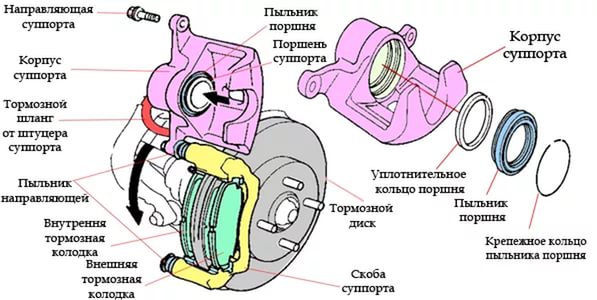
How disc brakes work
Content
Most modern cars use a braking system consisting of disc brakes. They are so called because they use the force applied to the discs attached to the wheels to slow down and stop the car. Compared to drum brakes, disc brakes provide more stopping power and don't overheat as quickly with heavy use. While some entry-level vehicles use drum brakes on the rear wheels, four-wheel disc brakes are commonly found on everything from family sedans to trucks and high performance sports cars.
Parts that make up a disc brake system
Rotor: A circular disc bolted to the wheel hub that rotates with the wheel. Rotors are most often made of cast iron or steel, however some very expensive vehicles use a carbon ceramic rotor. Rotors may have slots or holes for better heat dissipation.
Brake pads: The component that presses on the rotor, creating friction that slows and stops the vehicle. They have a metal part called a shoe and a lining attached to the shoe. The lining is what actually makes contact with the rotor and wears out with use. Liners are made from a variety of materials and fall into three categories: organic, semi-metallic and ceramic. The lining material you choose will affect the life of the brakes, the amount of noise heard when braking, and how quickly the brakes bring the car to a stop.
Cylindrical valve: The cylinder is connected to the hydraulics of the brake system. The piston is what moves the brake pads into the rotor when the driver presses the brake pedal. Some brake systems have a single piston that moves both pads, while others have two pistons that push the brake pads on each side of the rotor. Others still have four, six, or even eight pistons for more stopping power, at the expense of added cost and complexity.
Caliper: The housing that fits over the rotor and holds the brake pads and pistons, and contains the brake fluid passages. Brake calipers come in two types: floating (or sliding) and fixed. Floating calipers "float" over the rotor and have pistons on one side only. When the driver applies the brake, the pistons force the brake pads on one side into the rotor, causing the caliper to slide so that the pads on the non-piston side of the caliper also make contact with the rotor. The fixed calipers are bolted on and instead have pistons on either side of the rotor that move when the rider applies the brakes. Fixed calipers distribute brake pressure more evenly and clamp the rotor tighter, however floating calipers are used on most vehicles and are ideal for everyday driving.
SENSORS: The brakes of some vehicles are equipped with sensors built into the brake pads that tell the driver when the pads are worn. Other brake sensors play a role in the vehicle's ABS system.
How disc brakes work
Brakes should respond instantly. When the driver presses the pedal, a piston inside the brake master cylinder pressurizes the brake lines with hydraulic fluid, which moves the pistons and pushes the pads into the rotor. The harder the driver presses on the pedal, the more pressure will be inside the brake lines, and the more the pads will compress the rotor. The distance the pads travel is short - just a few millimeters - and they must retract back into the calipers as soon as the rider releases the pedal.
Disc brake wear
Even during normal driving, disc brake systems are subjected to serious stress and heat, and over time, some components will need to be replaced. Brake pads need to be replaced most often. When this happens depends on your particular driving habits as well as the material the pads are made of, but it ranges from 25,000 to 70,000 miles. Brake discs often last between 50,000 and 70,000 miles (and sometimes more), but can be damaged if they overheat or if the brake pads are not replaced on time. Brake fluid is the lifeblood of the entire brake system, so check it every 24,000 to 36,000 miles, or immediately if you suspect a leak. Pistons and calipers should last the lifetime of the vehicle, except when mechanical problems occur, they are damaged by debris or from an accident, or if they seize from inactivity.
Symptoms of disc brake problems
A few hard-to-ignore symptoms let the driver know they have brake problems:
Shrieking noise: As the brake pad material wears out, the metal wear indicator inside the pad begins to make contact with the rotor, making a high-pitched squealing sound. Replacing the brake pads usually eliminates the noise, but it can also be caused by road debris caught in the caliper.
Jitter or Pedal Pulsation: If the brake pedal pulsates or shakes when you press it, your brake discs are most likely warped. Brake discs need to be perfectly flat and deformation can occur due to overuse or overheating. Rotors can sometimes be upgraded to make them smooth again, although a direct replacement is often a safer option for the same price.
Spongy or low brake pedal: The brake pedal should feel good, and the braking force should match how hard you press the pedal. If the pedal feels spongy or lower than normal, this is often a sign of contaminated brake fluid or a leak in the system. The presence of air or water in the fluid reduces its effectiveness, and leakage is a serious problem. Have a mechanic flush the fluid or check the system for leaks to restore full braking power.
Brakes are arguably the most important safety system in any vehicle, and disc brakes provide reliable, long-lasting stopping power. They are most likely used in your vehicle, so keep an eye out for any unusual symptoms that may indicate a part needs to be replaced.